Final Report
Solongo's Final Report
Toward a society where deaf women can shine!
My background
When I played in my room at 2 years old, I became trapped under a bookshelf. My parents were surprised and took me to a hospital. However I lost my hearing ability because of medicine side effects. When I was 8 years old, I joined a school for the deaf and started learning sign language. But the teachers used a method of lip–reading, which children need to read the teachers’ lip movements, without sign language in every class. Because of lack of my abilities of hearing and lip-reading, I could not study sufficiently. I began to communicate with friends and parents in sign language.
Then, I entered Mongolian University of Science and Technology. In the university, I was the only deaf student. As everyone around me could hear, it was very difficult for me to communicate with them. The teachers offered lessons through only verbal communication. The way to get information in classes was to look into my friends’ notebooks from the side. I continued to study in this way for five years. Though I graduated the university, I could not get as good skills as my friends have. I decided to learn how to make clothes by taking a short-term course, then finally I was able to open a tailor shop. I work with my mother. I make clothes and she sells them. We have hired one woman who is a wheelchair user, her responsibility is simple tasks for our working.
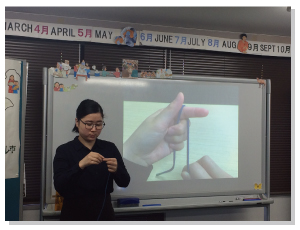
The purpose of my training
There were three things I wanted to learn in Japan.
- Building identity for deaf children
- Learning how Japan has developed
- Learning Japanese and Japanese sign language
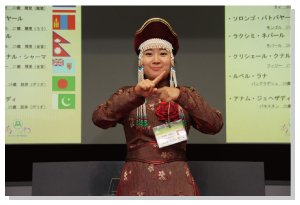
Many different training courses in Japan
First, I had spent three months for learning Japanese and Japanese sign language. Sign language was very hard to learn at first. But as I began to get accustomed to sign language through communication with my deaf friends, I began to enjoy it. In all honesty, learning Japanese was so hard that I did not understand kanji at all, but I had to work really hard because I was obliged to write reports every week in Japanese. Now I am interested in kanji.
I also visited Meisei Gakuen, a school for deaf children. These children can communicate by amazing sign language! Also their non-disabled mothers were good at sign language and communicated with their children by sign language. The teachers at school always use sign language for classes. I thought the school was wonderful, and I wanted to establish such a school in Mongolia.
At NPO Japanese ASL Signers Society, I learned how to make a presentation. I practiced very hard during this training because I had never made a presentation in Mongolia. I tried to do my best for learning a presentation, so when I was asked to make a presentation in Kagoshima, I could do it very well. I received many questions from audience after the presentation. I was very happy that many people came to see my presentation.
In the New Year, I went to Nagano to stay at home of Japanese family. The parents were deaf and the daughter was a normal-hearing person. I had made a Mongolian traditional clothes for her. It made her very happy. The family also gave me a chance to wear a kimono and take pictures together. They told many things about Japanese culture such as the New Year to me. When we visited the shrine to wish for a good start of this year, I drew a fortune slip. The slip said that I would succeed in work, so I was happy.
In January, I had a ski training course in Niigata with other Duskin trainees. I had an experience to ski in Mongolia before. I thought I could not ski at first because Mongolian ski slopes were gentle but Japanese ones were very hilly. However, I learned how to ski following my teachers’ instructions. Other trainees could ski well too. Their smiles made me happy. I extend my gratitude to our ski teachers.
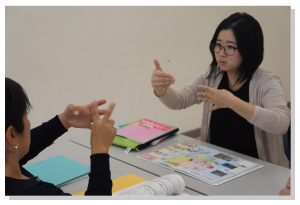
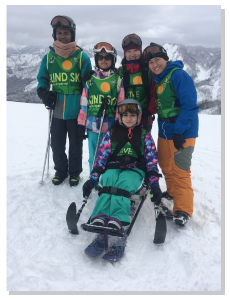
Training at Non-Profit Organization “DeafNet. KAGOSHIMA”
The place of my longest individual training is “DeafNet. KAGOSHIMA” whose president is Ms. Sawada, a deaf person. Ever since I had heard about Ms. Sawada’s organization activity, I really wanted to have a training there. “DeafNet. KAGOSHIMA” has five projects. I would like to explain three of them.
1.”Budo-no-Ki”
“Budo-no-Ki” is a workshop where deaf people and deaf people with intellectual disabilities are working together to make handicrafts and sew clothes. For deaf people with intellectual disabilities, the workshop provides tasks to them according to the character of their disabilities. I think that it is an effective to adjust a work to the character of disabilities. I took part in the handicraft work and picked up a wonderful idea. During sewing, I used to throw away the fabric scraps even if it is waste to do. At “Budo-no-Ki”, the workers collected these scraps and made cute stuffed animals. These accessories would be perfect small gifts. I think that it is a wonderful way to make profit from the unnecessary scraps.
2.”Satsuma Waffle”
In Satsuma Waffle, deaf people and deaf people with intellectual disabilities work together to make and sell waffles. I tried to make waffles by myself but it was incredibly difficult. People with intellectual disabilities made much better waffles quickly than I did. As the waffles are really delicious, I strongly suggest that everyone should eat them.
3.”Deaf Kids”
Deaf children go to school during day time, and then after finishing a school the staff of Deaf Kids or parents go to there to pick up the children in order to take them to Deaf Kids. Deaf Kids is not only a place for playing, but also a place for doing homework with the support from the staff. Their parents can communicate with their children about anything since they are good at sign language. The staff is fluent in sign language and also have a specific knowledge about the way of instruction for children.
At Deaf Kids I learned that communication is the most important to understand each other deeply. For deaf children, sign language is the best way of communication. The second is knowledge. When I go back to Mongolia, I would like to share what I learned in Japan with many deaf people.
Activities I want to start in Mongolia
1.Sewing class for deaf women
When I arrived in Japan, I hoped to establish an identity for deaf children but as my training progressed, my feeling changed. At first, I want to support deaf women. One of my friends is a leader of deaf women in Mongolia. I want to ask her to support my activity to start a sewing class. She has responsibility for management of association for deaf women. I learned many things how to establish a sewing class in Japan. It is impossible for me to do the project alone. I want to ask her to cooperate and move forward.
2.Independence of deaf people
In Mongolia, many deaf people live with their parents. It is difficult for them to live independently. I want to support them for employment, and then I hope that deaf people can get their own salary and live independently.
3.Teaching sign language to deaf children and their parents
Deaf children and their parents cannot understand each other without communication by sign language. Through sign language instructions, I want to support communication between deaf children and their parents.
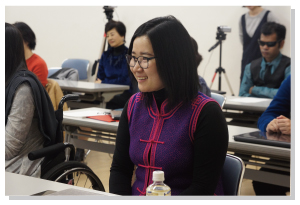
Acknowledgments
We had many opportunities to go to various training places, and obtained a lot of knowledge and information. We totally grew up, compared to September in 2017 when we came to Japan. I really want to express my appreciation to everyone who is related to the Duskin AINOWA Foundation and everyone who helped me during my stay in Japan. Thank you so much.




